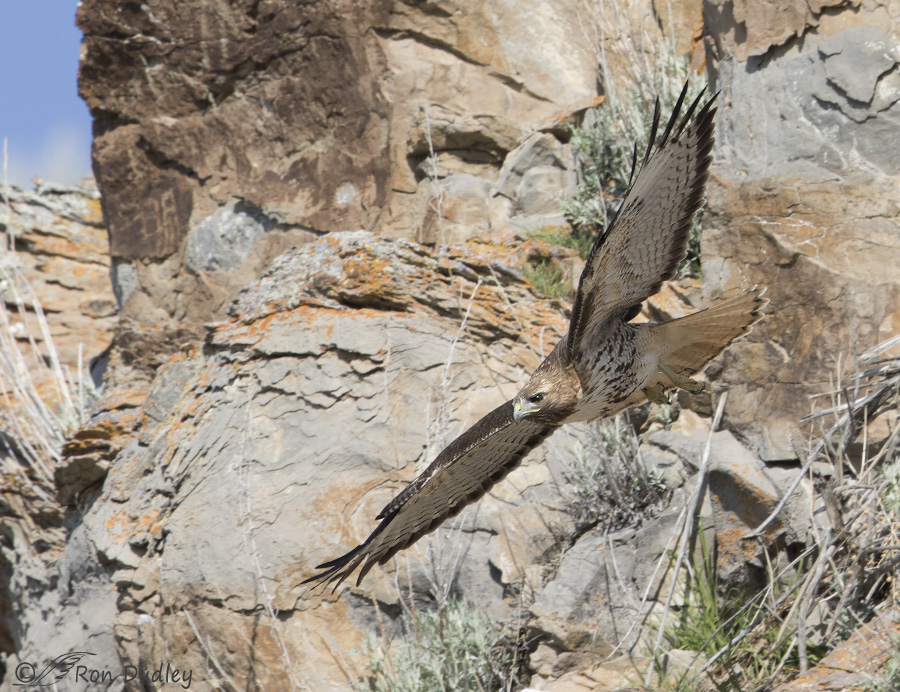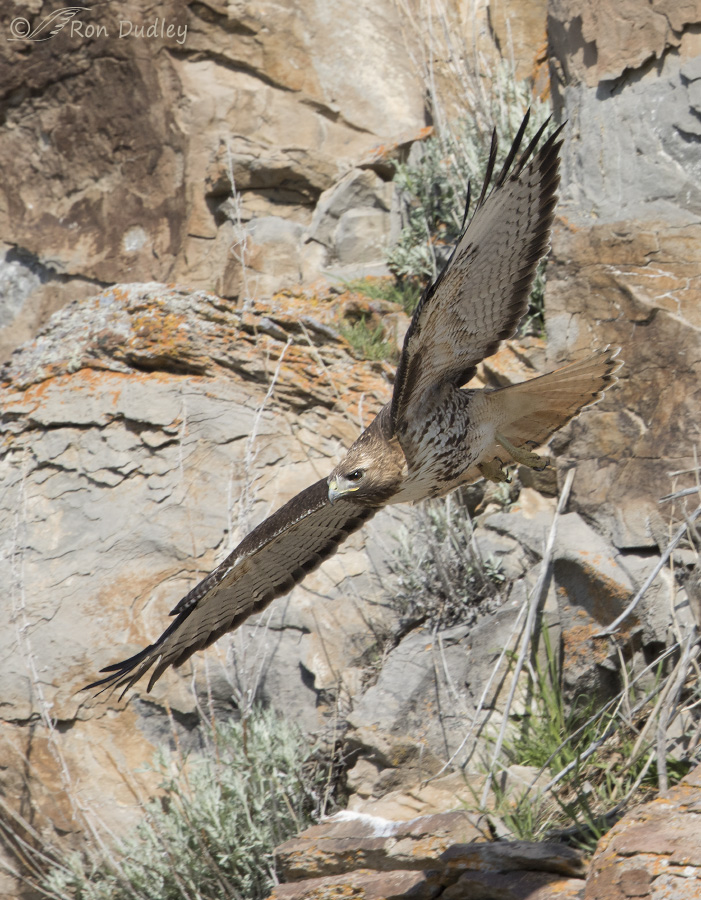I believe this is the male of a nesting pair of Red-tailed Hawks I photographed yesterday in northern Utah.
1/1250, f/7.1, ISO 400, Canon 7D Mark II, Canon EF 500mm f/4L IS II USM + EF 1.4 III Extender, not baited, set up or called in
The female appears to be on eggs but the male continues to deliver nesting material to the nest. Here he’s flying against a backdrop of the cliffs in the vicinity of the nest soon after one of those deliveries. A setting like this is likely a little busy for some tastes but it actually appeals to me for its good look at the typical natural habitat these birds often nest in.
I struggled with how to compose this image when I cropped it. This version provides a better look at the rugged and layered cliffs and has more depth…
but a vertical crop makes the hawk larger in the frame and gives us a little better detail on the bird. Since I couldn’t decide which composition I prefer I decided to include them both.
With the background so close to the subject I find it very difficult to get the flying bird sharp in this situation. This was one of my better results.
I had a grand time with these hawks yesterday in the few minutes I spent with them so you’ll likely be seeing more of them in the fairly near future.
Ron




I like the vertical version as it focuses on the flight of the bird. One other small point (perhaps an issue with my monitor) is that I would drop the highlight level down a tad to boost contrast, allowing for more detail in rock background.
Thanks for your feedback, Jeremy. You may be right about the hightlights – can’t remember if I did it or not…
Ron, I think the second (vertical) crop emphasizes the hawk more. Although it is an illusion and not real he seems to be descending in the vertical crop rather than in the dependent part of the frame in the first version. That gives him more power and presence–and he deserves it–in my humble opinion.
Stephen Clayson
By jove I think you’re right, Stephen – the vertical crop gives the viewer the perception that the hawk is descending more steeply than in the horizontal crop. I hadn’t noticed that…
And it removes the rather dominant rock face in the upper left again giving emphasis to the bird. Powerful shot, my friend.
I like both shots, but lean (slightly) towards the first because it gives me a better sense of location. Thank you for including both.
And thanks for enjoying them both, EC. And explaining the reason for your preference.
I lean a little toward the first crop because I like the context and there’s so much visual interest. The pop of sky opens the background up for me so it doesn’t look as cluttered. That being said, I do like the bird detail and the shadow in the second version. It’s like you’ve asked me what kind of donut I want — can I just say yes?
Yes, you certainly can, Marty. Thanks for your thoughts on this.
Excellent shot, I like them both, but lean toward the cropped version. I bet that was a ton of fun for you!
Been babysitting a box I put up yesterday, the 10th, for a pair of Tree Swallows who seems to like it. Trying to keep the Starlings and House Sparrows from usurping!
Spring has finally come!!
Thanks, Dick. Fun it was!
I’m like you Ron, I like both. Often I work the crop tool and let my subconscious make the call. Often the creative part of the brain works best in that area I am told. If I had to make the call, I would make the vertical one as well, but it would probably be after playing around a while with the crops to see what felt right. On another note, Ansel Adams used quite a bit of darkroom work to create his images yet today we have moved away from treating images with those processes. I was thinking as I looked at yours some of the stunning effects that could be wrought with contrast of foreground and background. We sacrifice a lot for purity of the moment artistically sometimes. Just thinking out loud not critiquing. It is a shot I would be deliriously proud to have captured, I know you are. My mind was wandering artistically about processes beyond the capture.
Ron, I too play around with crops when I’m processing. Photoshop makes doing it quite easy and quick and I enjoy doing it.
“Photo-art” just isn’t my style so I don’t do those kinds of manipulations with my nature photography.
Well, you know, for me the bird’s the thing — especially Red-tails — so I’m voting for the second one, where he is the focus but there’s still the sense of his environment. Looking forward to seeing the female!
Thanks, Chris. I suspect I’ll post some that include the female within a few days.
Great picture(s?)!
On that badger post where the badger buried a calf: You said you shot lots of gophers! I certainly get why! I was in calgary his weekend with my grandpa, and and I saw a lot critters seen often on this website. Richardson’s squirrels, magpies, jackrabbits, geese, goldeneyes, etc. But what did you do with the gophers once you shot them? Probably not eat them, because people tell me squirrel is oily and tough, and those gophers are so tiny anyway. And also because if beetles buried them, they would’ve been left out in the field. But in an older blog post, you said the price was a cent a tail, so did you skin them and bring the skins somewhere? Most folks here just kill a gopher and leave it around or throw it out. But they are actual pocket gophers here. Forgive my stupid questions!
Levi
Levi, Usually we just left them where they were shot. For a few years when I was quite young we turned the tails in for a penny “bounty” each. We just cut the tails off and turned them in for the bounty. I gave that practice up real soon because those tails stink after a while.
I’m glad my gopher shooting days are far behind me. These days when I go back to the farm I only aim at them with my lens.
Here’s an interesting aside. They still kill gophers on the farm (they pretty much have to given the crop damage they cause) but for a few years there were some white gophers in amongst the others. I never saw one myself so I don’t know if they were true albinos (pink eyes) or just leucistic but no one killed those gophers because they were so interesting. They lasted for quite a few years, generation after generation, despite the distinct survival disadvantage of being white.
That is interesting! They’re a lucky bunch in winter, but in summer they gotta be on their tippy toes every second! Funny how such a serious thing as survival can change so drastically. One minute it’s in your favor, and the next it’s not.
The first image, in my opinion, is definitely the best because image #2 feels too tight. I say let the beauty of the environment enhance your wonderful photography.
You make a valid point, Marian. Thanks.
These are both great shots…for different reasons…like the peek at blue sky in the first, gives a good sense of the total location, and the close up with shadow in the second…glad you included both…hope you do that more often…lets us see what you saw and what we’d see if we were lucky enough to be there, too.
Beautiful wing position…
Patty, I’ve actually been thinking about doing something similar with a Turkey Vulture shot sometime soon. So given your encouragement maybe it’ll happen…
Ooooh a turkey vulture! Yes, please!
To my taste, #1 gives me a much stronger feeling of “being there” and #2 let’s me enjoy more of the finer details of the Bird. Can’t lose either way.
Bill
I’m glad you like them both, Bill. Thanks.
I just returned from a trip to Panama and Costa Rica and saw numerous birds but the photography I got will never compare with yours. So beautiful and your blog is so informative. I recommended your blog to a Bird Biologist I met on the trip, who is living on the Oso Peninsula in Costa Rica.
Thanks for spreading the word, Betty.
I like the first best, just looks more complete. Great shot.
Thanks, Jo.
I really like the shadow of the bird in the second crop, it gives a sense of depth, but I also like the bit of sky and the shape of the rocks you can see in the first crop, giving the bird someplace to go in the frame.
Sounds like you’re torn between the two compositions just like I am, MK. Thanks for that feedback.
Beautiful vertical or horizontal! Guess it depends on what you’re after. I prefer the horizontal as it gives more context, BUT! Glad you had a glorious time with them – they are gorgeous!
Both of them truly are gorgeous, Judy. You’ll be seeing the female soon. Thank you.
What auto-focus settings do you use in situations like this?
Brad, For this shot I was using Case 1 on the Mark II.
Supersh9Ron!
Thanks, Charlotte.
Hi Ron, I’m back from a vacation and had a nice time this morning sipping coffee and catching up on all your blog posts since I left. Thanks for the beautiful photos and sharing the “Nuts and Bolts” of your life working on the blog. What an incredible amount of work! I’m so grateful that you do it, because we learn so much and get inspiration from all the photos – both the successful ones and the ones you do not consider to be so great.
For what it’s worth, I prefer the 2nd cropped photo. It shows the cliffs as well as the detail of the bird.
Welcome back, Joanne. And thanks for your feedback!
I can see your dilemma in choosing one of the shots, they both have their merits. Glad you shared both!
I still don’t know which one I prefer. Thanks, Dominique.